MICHELLE STAMPE: TRAINING FOR JAY P’S 200K BACKYARD FAT PURSUIT PT 2
Posted by Steve on 12/13/18
Last modified: 02/01/21
The 2019 Fat Pursuit is an epic fat bike race through West Yellowstone, mid-winter. It comes in two flavors, both a little sour for most: 200 kilometers and 200 miles. In January. The 200k course winds its way through 124 miles of snowmobile trail, climbing over 6,900 feet of elevation. Something willed me to hit the “submit” button, and I will be driving to Island Park, Idaho, to share the start line of the 200k Fat Pursuit with the other racers.
If you’re a seasoned gravel or road rider and you’re looking at this event, you might be thinking, “That doesn’t sound like much distance or elevation!”
Now imagine doing the course with a 50lbs bike with 4.6 inch tires with a PSI set to 5,—in a blizzard. Ouch.
The 200k racers begin at 7:00 a.m. on Saturday morning, and have until Sunday, January 6, 6:00 p.m. to ride over 100 miles to the 3rd Checkpoint. That’s 100 miles in 35 hours. The math left me pretty sober the first time I got out my paper and pen. You mean it could take me longer than 35 hours?!?
Racers can be slowed to a crawl by snowstorms, extreme cold, and varying snow conditions. The course could be dumped on at any time. The extra snow on the groomed trail easily turns a 20-hour race into a multi-day suffer-fest. I’m not sure if I’ll experience conditions that allow me to finish in 24 hours or 40 hours. Paired with low temps and challenging terrain, you can see why a lot of people end up throwing in the towel. One year the temps dipped down to -40 degrees F/C. That is such a cold temperature I can’t even imagine what that feels like—I don’t have any experience to compare it to. I don’t think very many people do.
For those that are persistent, prepared, and a bit lucky, they are rewarded with all that Yellowstone has to offer: incredible views, desolate terrain, and the kind of experience that pushes you to go far beyond what you think you’re capable of. I hope I’m ready.
When friend and riding partner, Kristi, suggested riding The Pursuit with her this year, I decided, “What the hell. Why not?” My impulsiveness gets me into trouble sometimes.
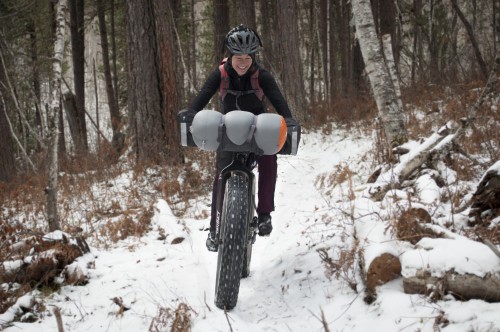
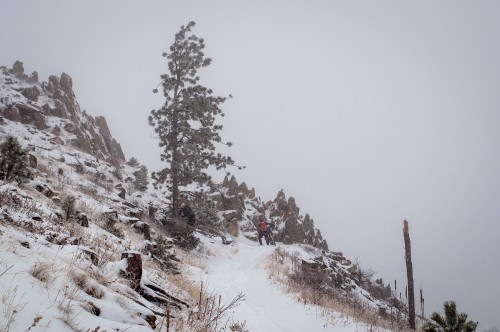
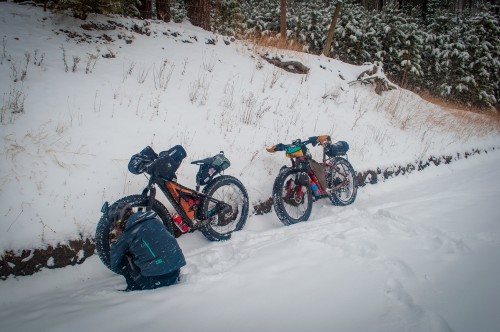
I wonder if I said “yes” because I just turned 25. The idea that I have now lived a quarter of a century terrifies me. There is something about that number—being closer to 30 than 20, if you’re rounding up—that I find downright scary. In the same vein, I suppose I said “yes” because I want to find out if I can actually do it. I think there is so much value in committing to something that terrifies you and then preparing yourself for it as best you can.
So how does a regular, mortal human like me get ready for this kind of undertaking?
With the Pursuit less than a month away, I’ve learned a lot about what not to do while training for a winter ultra. This is the advice I’d like to give myself, some practical and some anecdotal, if I could go back in time.
If I don’t have a solid foundation built on all three, I won’t be able to finish the race.
IT’S NOT JUST ABOUT FITNESS
ULTRA ENDURANCE TRAINING IS ONE PART FITNESS, ONE PART GEAR, AND ONE PART ATTITUDE.
When I started training a few months ago I was completely focused on fitness. That’s all I could think about. I have to be strong enough for this race. Once I realized that my bike could literally weigh half my body weight, I started to sweat.
However, when the snow started to fall and I began spending my weekends riding to remote, snowy cabins I realized that fitness was just one part of surviving in the cold. An important element, but certainly not the only one.
Another huge part is attitude. I’m not always a glass half full kind of person, and as I continued to train in less-than-perfect conditions it dawned on me that I needed to work on my disposition as much as my fitness, if not more. Slowly and intentionally I’ve transformed into someone who rides no matter the weather, and is happy to do so. When I’m caught in the cold or I push my limits, I smile and remind myself, “This is your choice. Enjoy it.”
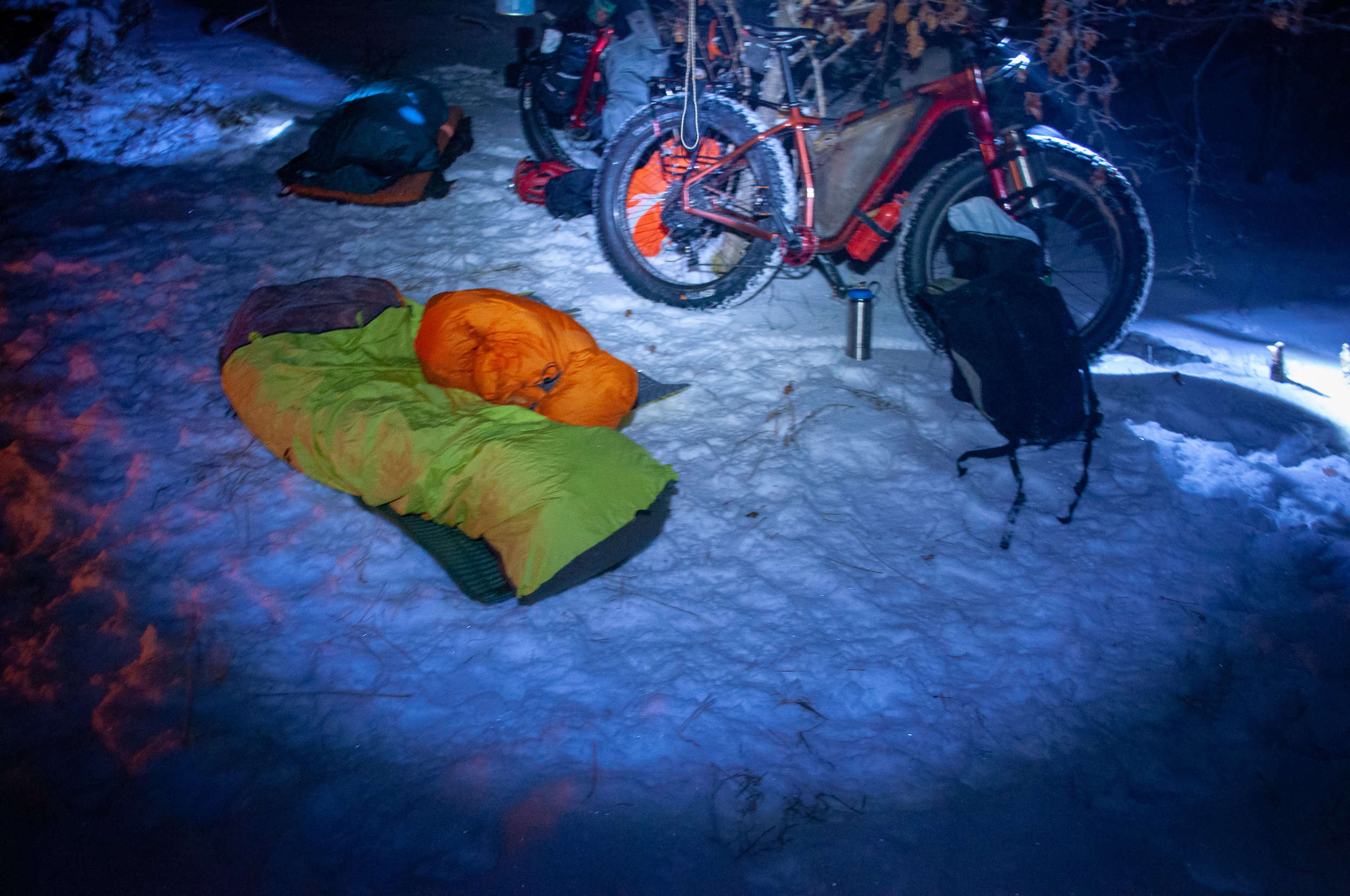
So often I think we are led to believe that we have no control over our attitude. I used to think my personality was like the color of my eyes—unchangeable, static. That it was genetically determined, and I simply was the way I was. That if I wanted to change something about myself it would take a lifetime of dedication and practice.
During my countless hours in the saddle in preparation for this race, I’ve realized that attitude is the most malleable of all three elements (fitness, attitude, and gear). A positive attitude in the face of fatigue or cold is actually pretty easy to attain. As soon as I chose to feel differently about tough situations, I actually responded more positively to them.
Lather, rinse, repeat.
Every time I train my body I also train my mind. I spend a lot of time visualizing myself hunkering down through a blizzard, changing the batteries in my headlights in -10 degrees F, hopping off my bike to run because I can’t feel my toes, and pushing my bike over the finish line if I have to. I think it’s my way of testing my reaction to tough scenarios.
I’m not saying that I’m always the most cheery person, but I am saying that personality and attitude isn’t predetermined. We do have agency to influence the way we handle ourselves.
When I began spending 10-15 hours a week on my bike, I had to pull those hours from somewhere. That’s not to mention all the time spent researching the course, investing in gear, and working on my bike. The race has become a second job. I sort of understood this going into training, but I hadn’t figured out where I’d find the extra time.
SOMETHINGS GOTTA GIVE
I KNEW THAT TRAINING FOR THIS RACE WOULD TAKE UP A LOT OF TIME (AND RESOURCES). WHAT I DIDN’T CONSIDER WERE THE SACRIFICES I’D HAVE TO MAKE.
I am an entrepreneur, and some of those hours came from my work schedule. Most came out of my personal time. That meant less hours spent walking my dogs or enjoying a glass of wine with my partner. It meant more time focused on myself, and less time focused on others. I’ve had to learn to be selfish these past months.
Getting out and actually using your gear will teach you a lot. For example, on day 1 of using my Jet Boil I realized that it’s a pretty dumb idea to store my lighter in the pot. At first, that makes sense: why wouldn’t I store what I need to light my stove, inside my stove? However, before you pack your stove back up, you need to cool it down so it doesn’t melt any of your gear. The easiest way to do that is by putting some snow in it. The next time you pull your stove out, your lighter will likely be too wet to ignite.
LEARN HOW TO USE YOUR GEAR
DON’T LET THE FIRST TIME YOU USE YOUR STOVE BE AN EMERGENCY.
For that reason, I’ve started storing multiple sources of fire in different places on my bike. You never know when you’ll have to use that fire starter.
Another crucial piece of gear to nail down is your hydration. Are you going to try to use insulated bottles or a hydration pack? How will you keep your water from freezing? How long does it take your insulated bottle to freeze, and at what temperature? If you’re going to use a hydration pack, what layer will you wear under it, and what layer will you wear over it? Does your coat actually fit over your reservoir? Will you run the hose under your armpit? What if the bladder tears or punctures—will you keep it in a dry bag? I ended up modifying an old hydration pack so that the hose can easily run under my armpit, but I haven’t solved the dry bag situation yet.
Technology acts strangely in the winter. Cell phones, cameras, and headlamps never seem to last very long in the cold. Since I started training, I’ve learned that my rechargeable lights are not reliable and do not last long enough for a winter ultra. Actually, all my technology is now battery operated, and I have extra lithium batteries stored on my bike.
Where will you carry your fuel canister? In the photo below, I have my MSR fuel in a water bottle cage. I was pleasantly surprised by how well it fit! I wasn’t pleasantly surprised by the thick casing of ice and snow around the top of the canister.
There are so many variables to consider that it will take months to get comfortable with your setup. Don’t wait until race day!
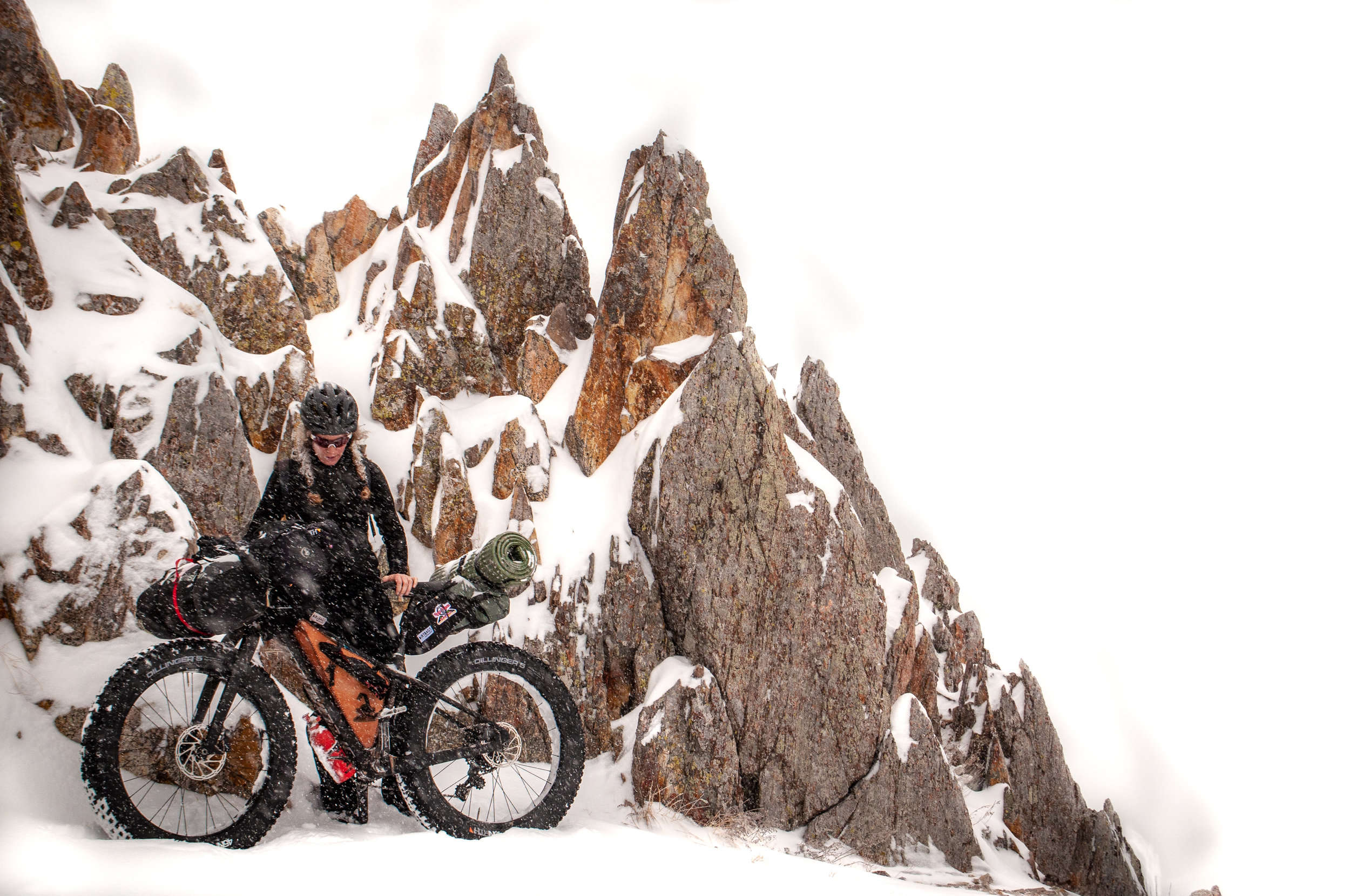
Fatpacking attempt #2: Global Fat Bike Day
LEARN HOW TO PACK YOUR GEAR
“WHERE IS MY CHAPSTICK?” PACK AND REPACK YOUR BIKE A MILLION TIMES.
I now have 3 winter bikepacking trips under my belt, and I wish I had more. I’m still packing and repacking my gear, trying out different bags, and learning what needs to go where.
Initially, I thought it would be pretty straightforward: pack the most essential piece of gear on top of everything else. However, with winter bikepacking every piece of gear is essential. What piece of gear needs to be the most accessible? My stove, or my puffy? My snacks, or my goggles? My answer is all of them! I’ve had to make a few alterations to my setup in order to be able to grab whatever I need, whenever I need it. I simply can’t afford to have to pack and repack any gear while on trail—the conditions might not allow me to.
I also recommend packing and repacking your setup while using gloves. Which buckles are easy to clip and unclip? Are any buckles tiny enough that you have to take off your gloves to unclip them? It’s a good idea to have your emergency gear in a bag you can access while wearing bulky gloves.

Learning the value of liner gloves. Burrrr!
BEWARE OF OVER-TRAINING
ARE YOU DOING MORE HARM THAN GOOD?
Like I mentioned earlier, the first month of training I was focused on increasing my base fitness. The goal was to gently ramp up my total hours on my bike, with the final week compensating for the fatigue of the last three weeks.
Over the last few months I’ve learned two things:
I was so excited to start training that I hit the first few weeks as hard as I could. I ended up going way over my planned mileage and overtrained. I had to take over a week off from riding to recover. In hindsight, it didn’t set me back too far. However, it was mentally taxing. I spent a lot of time worrying and calculating whether or not I would have enough remaining time to get into shape for the Pursuit.
Overtraining does more harm than good
Gently increase base miles
At first, it’s hard to know how much is too much. Next time I train, I’ll use Strava to find my average mileage and then increase my weekly hours on a bike by only 30 minutes each week.
I also realized that my final big weeks in the saddle were just too many hours. I was expecting myself to have a 20 hour week! If I could go back in time, I’d never schedule more than 15 hours in a week. It’s simply too much time in the saddle for me. Besides, I’m not a pro athlete and I have other things going on in my life that demand time and attention.

We found ourselves rolling into out-of-the-way Mom & Pop restaurants for a much needed cup of coffee and a burger.
DON’T GIVE IN TO DOUBT
THERE WILL ALWAYS BE DETRACTORS.
I am lucky to have a group of wonderful riders and friends that have been incredibly supportive through training. They’ve kept me motivated and accountable. They’ve given me encouragement and advice. They’ve been resources for me to derive inspiration from when I’m feeling overwhelmed. Find those few people, hold onto them, and don’t listen to anyone else.
I’ve encountered a lot of doubt and negativity from outside my circle of riding partners. I was blindsided by it. I naïvely thought that people would simply nod their heads when I told them what I was training for, like it was the most normal thing in the world. To me, it doesn’t make sense that I should have to justify my desire to experience something challenging and out of the ordinary. Isn’t that what we humans do?
I’ve realized that not everyone sees the world through the same lens as me. I had a lot of people look me up and down with a raised eyebrow, as if they had already determined what I am (and am not) capable of with a single glance. Some people even questioned whether I knew what I had signed up for, asking, “Do you even know how far 200k is?” as if I hadn’t already spent months memorizing the map and elevation profile. Still others offered up a backhanded compliment, like “You must be crazy to think you can do that.”
I think they’re crazy not to try. When I start to doubt myself, I think about what it takes to show up at the start line. I remind myself that deciding to gear up and try is the hardest part of any race. From that perspective, I’m already over the crux.
I’ll spend these next three weeks studying the map, memorizing each turn and each climb. I’ll write up my own cue sheet—just like taking notes in college. I’ll closely monitor the temps in Island Park (the start point) and West Yellowstone (a major checkpoint). I’ll leave my bags on my bike and pack and repack it a hundred times. I’ll continue to use my stove in the snow. I’ll be experimenting with my hydration pack, insulated bottles, and vapor barriers. I’ll taper my riding—10 hours this week, 9 hours next week, 7 hours the week after that, and just a few short spins on race week. Mostly, I’ll spend my time looking forward to race day. I’ll get nervous, then calm, then confident, and then nervous again. The cycle will continue until January 5.
FROM NOW UNTIL RACE DAY
Until then, I’ll see you on the trails!
For more great reviews, blogs, how-to’s and some killer photography, head over to Shredworthy!
